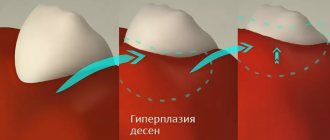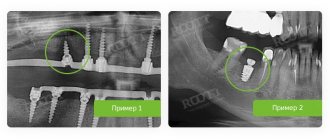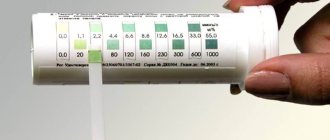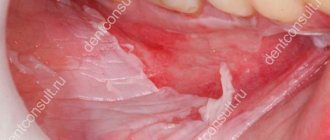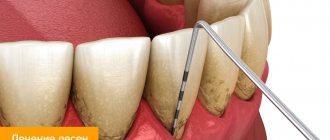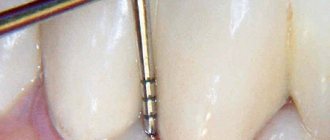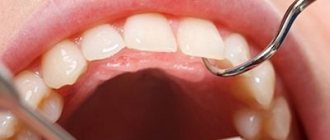Author of the article:
Soldatova Lyudmila Nikolaevna
Candidate of Medical Sciences, Professor of the Department of Clinical Dentistry of the St. Petersburg Medical and Social Institute, Chief Physician of the Alfa-Dent Dental Clinic, St. Petersburg
Doctors consider any burns on any part of the body to be the most painful injuries. With such damage, large areas of the skin are affected and nerve endings are damaged. Burns have a long recovery period and very unpleasant symptoms. And gum burns are especially painful. We will talk about what to do if you receive such an injury and, importantly, how to avoid it, in this article.
Why are gum burns dangerous?
Despite all the external harmlessness, any gum burn can lead to serious consequences. Firstly, after an injury it is easy to introduce an infection into the soft tissues and cause complications. Secondly, with severe burns and significant lesions, necrosis of the mucous membrane occurs, which requires immediate intervention by a specialist. It is important to remove dead tissue as soon as possible to prevent necrosis from spreading further.
Do not forget that the thin layer of epithelium in the mouth is a huge number of capillaries. It is the gums that ensure the correct and strong fastening of the teeth; it is the gums that keep our smiles beautiful and even for many years.
Causes of bumps
The formation of lumps on the gums causes an inflammatory process of soft tissues, as a result of which pus accumulates in the thickness of the gums, forming noticeable swelling. This suggests that the disease that caused the inflammation has reached an acute stage and is progressing. The most common reason for developing pus-filled or hard bumps on the gums is poor oral hygiene. But there are other sources of inflammation on the gums that a dentist can identify:
- Gingival fistula - swelling has a diameter of 3-6 mm with a white tip on the surface (an outlet for purulent contents). May be located above or below the tooth. If a fistula on the gum is not treated in time, the acute process of inflammation can become chronic.
- Periodontitis - looks like a compacted swelling; patients describe the problem as “a hard lump on the gum.” The diameter of the formation can be up to 1 cm and does not cause pain. Hard lumps appear as a result of pulpitis or unfilled teeth. If the purulent focus is not eliminated in a timely manner, it will lead to a granuloma or cyst.
- Gingivitis is a disease caused by insufficient oral care. It manifests itself as slight swelling and redness of the gums with bleeding. Therefore, the formation is often called a “red bump on the gum.”
- Periodontitis – gum tissue becomes inflamed due to the accumulation of bacteria in the gum pocket. Which, in turn, forms between the loosened tooth and the gum. Bacteria cause a purulent process and swelling in the form of a whitish lump.
- Epulis - develops as a result of mechanical trauma to the gums (unsuccessful filling, uncomfortable prosthesis, sharp edges of neighboring teeth, etc.). Globular swelling on the leg (mushroom-shaped) has a bluish tint and can reach a considerable size - up to 2.5-3 cm. Most often it affects the lower jaw and is most common among women. It can also affect the gums of children when teething for the first time.
- Hematoma - may appear after injury during tooth extraction. The swelling is watery in appearance, usually soft to the touch and may be slightly painful.
Thermal burns
The most common injuries to the oral cavity are household thermal burns of the gums and mucous membranes. Each of us has received similar damage at least once in our lives: a careless sip of too hot coffee, and now we are suffering from unpleasant symptoms:
- blisters and bubbles filled with liquid appear on the gums;
- the gum surface becomes rough;
- bothered by continuous aching pain, which intensifies when touching and eating food;
- dryness may occur.
Contrary to common misconceptions, severe thermal burns are very dangerous for gums and can lead to disastrous consequences. Dentists distinguish several stages of development of a thermal burn:
- The gums turn slightly red and recover quickly. The patient feels almost no pain and, if desired, can quickly cure such a gum burn at home.
- Blood rushes to the gums, the tissues begin to darken, swell, some areas become white, and become very hot. Blisters appear on the surface of the gums.
- The mucous membrane is significantly (sometimes almost completely) hidden under blisters and is severely damaged. The pain becomes unbearable. Immediate medical intervention is required.
- The gums bleed profusely and become covered with flaps extending from the bone. The patient's jaw base is exposed, and there is a high risk of developing necrosis.
In more than 90% of cases, gum burns received in domestic conditions are first and second stage injuries. In such cases, fortunately, hospitalization is not required, and the discomfort can be relieved with pharmaceutical products.
Chemical burns
Another common type of injury to the oral cavity is a chemical burn to the gums, which occurs as a result of taking various medications and reagents.
Dental burns
A common type of chemical burn is injury to the gums during whitening with special compounds and polymers and dental treatment. Inattentive doctors can violate the application technique, and then drops of solutions and compositions will fall on the gums and burn the delicate mucous membrane when treating tissues with a UV lamp.
Dental chemical burns to the gums are particularly dangerous injuries. Such injuries are characterized by rapid development of deep wounds and death of soft tissue.
Work injuries
Employees of hazardous industries or finishing workers also suffer from chemical burns to the gums. Injury can occur both through contact with acids, metal salts and alkalis, and through their careless use.
Domestic injuries
Unfortunately, most often children who suffer from chemical burns to their gums are drawn to taste household chemicals. Some adults also suffer chemical injuries when they decide to try unlicensed gum supplements, medications, soothing agents, or toothpastes from unknown manufacturers.
Symptoms of chemical burns
Chemical burns to the gums do not manifest themselves in exactly the same way as thermal burns. This type of injury is characterized by the following manifestations:
- voluminous blisters on the gums;
- swollen tissue;
- severe pain, itching.
How to treat burns?
Gum burns are very unpleasant injuries. A person immediately feels a sharp pain, which can spread to the roots of the teeth and temples. It becomes difficult not only to eat food, but also to swallow saliva. The tongue constantly probes the rough surface and swollen areas. Many people note an unpleasant metallic taste in their mouth.
First aid
First aid depends on the type of gum burn. In case of domestic injuries, you must act according to the following scheme:
- First, rinse your mouth thoroughly with clean water. Thus, the patient removes food debris and reduces the temperature. There is no need to swallow the water; a new portion should be taken after a minute. Some patients are helped by “freezing” the nerve receptors with pieces of ice.
- Then the mouth can be rinsed with antiseptic preparations. An excellent healing agent for household injuries, including burns of the gums, is Asepta Active oral skewer. This remedy combines a combination of the anti-inflammatory, analgesic component benzydamine and the antimicrobial component chlorhexidine. This complex provides the antiseptic effect of the skewer while simultaneously relieving inflammation and pain, which increases the effectiveness and quality of tissue treatment.
- If desired, the burned area can be treated with sea buckthorn oil and rinsed with furatsilin solution or chamomile decoction several times a day.
Treatment of chemical burns to the gums should be entrusted to a dentist. Such injuries require maximum care and caution. Substances can react even with ordinary water and cause inflammation.
For chemical burns of the gums, self-therapy is strictly not recommended. If the treatment is incorrectly selected, the patient may develop a fever and experience throbbing pain in the burn area. In advanced cases, people experience swelling in the throat and swallowing becomes difficult.
In each specific case, the dentist develops individual therapy:
- For acid burns of the gums, rinsing with alkaline solutions (for example, water with 1-3 drops of ammonia, apple cider vinegar or a pinch of baking soda) is prescribed.
- If the burn is caused by phenol, doctors prescribe ethyl alcohol and castor oil dissolved 1:1 with water as treatment.
What should the patient do?
At home you need:
- rinse your mouth with an antiseptic solution 2-3 times a day
- take pain medication
- there is on the opposite side
- consult a doctor as soon as possible for professional help to avoid the development of complications.
Getting food between the teeth often occurs either due to divergence of teeth during periodontitis, or due to the absence of the lateral part of the tooth when it is fractured or destroyed by caries, or due to shrinkage of the gums and bone due to bone melting during periodontitis or due to the roughness of composite fillings or ceramic crowns in as a result of long-term use.
What should the patient do:
- Try to remove food debris not with a toothpick, but with dental floss,
- Contact your dentist to restore the tooth wall or smooth out the filling and crown.
If you do not pay proper attention to this condition, food debris can get deep into the tissues and cause suppuration.
Gum mobility is one of the unpleasant conditions that causes swelling and pain, as well as the development of root caries.
When you eat, food debris gets deep into the tooth, and trying to remove it causes terrible pain. Brushing your teeth in the morning and evening also causes the gums to shift, which is accompanied by unpleasant sensations.
How to help a person whose gums have become mobile:
- Take liquid food
- Eat on the opposite side
- Use a soft toothbrush
- Brush your teeth with sweeping movements
- Immediately contact a periodontist for a full examination
Clinical researches
Repeated clinical studies have proven that the two-component oral skewers ASEPTA ACTIVE more effectively combats the causes of inflammation and bleeding compared to single-component skewers - it reduces inflammation by 41% and reduces bleeding gums by 43%.
Consumer Reviews
Natasha (vseotzyvy.ru)
“Mouth rinse Vertex JSC Asepta mouth rinse is sold in pharmacies, that’s why I bought it, it has more medicinal properties than just a cosmetic product, and indeed this rinse perfectly removes bad breath, disinfects gums, menthol gives freshness for almost a day perfectly helps smokers."
Dilya09 (otzovik.com)
“Hello to all readers of my review! I wanted to tell you my story about how I started using the Asepta oral brush.
It all started with the fact that I had an implant installed instead of an extracted tooth and was given strict instructions to rinse my mouth with chlogrexidine and, preferably, an oral scavenger. At the pharmacy, my choice fell on the Asepta drug, despite the price, because after the implantation procedure I had the feeling that now I would brush my teeth after every meal and rinse my mouth (it was just creepy). The price of this skimmer in pharmacies is above 160 rubles.
It doesn’t taste very nasty like some skimmers; after rinsing, it freshens your breath due to the “Lime” and “Mint” flavors. By the way, I don’t use it regularly anymore, I often forget to rinse my mouth, but, nevertheless, it is always present in the bathroom.
Of course, over the years, the memories of implantation have become dull, much has been forgotten, but Asepta and I are now friends. I take not only the skimmer, but also toothpaste. In general, not only is the skipper good, but the whole series is good. I recommend it to everyone who uses oral skewers.”
How to avoid complications?
In order not to aggravate the situation when treating gum burns, it is important to be attentive to yourself until the injury passes.
- For any type of gum burns, dentists do not recommend eating spicy, sour, or salty foods until the tissues are completely restored. Strong flavors irritate the affected tissues and can significantly prolong the healing process.
- You should not eat too hot foods - both during treatment and in the future, when the gums recover after the burn.
- All medicines, household chemicals, paints, solvents, and building materials must be stored in specially designated areas out of the reach of children.
If the pain from a burn becomes excruciating, we can take painkillers or use light anesthetic gels with analgin or benzocaine.
Complex gum burns, in which soft tissue dies, can only be treated surgically. The doctor in the hospital removes dead pieces of tissue and covers the damaged areas with donor parts. Such a “jewelry” operation often requires repetitions and additions. After treatment, the surgeon must prescribe antibiotics to the patient so that bacteria and microbes do not appear in the wounds and dangerous suppuration does not begin.
We hope that all of the above tips on caring for burnt gums will be for informational purposes only. Be careful and attentive to yourself, and accidents will bypass you.
Sources:
- The problem of treating inflammatory periodontal diseases in patients suffering from type 2 diabetes mellitus E.A. KHROMOVA* Ph.D., Associate Professor of the Department I.V. KULIK* Ph.D., Associate Professor of the Department N.A. UDALTSOVA**, ***candidate of medical sciences, associate professor of the department; Deputy Chief Physician for Organizational and Methodological Work A.K. IORDANISHVILI****,*****Dr.Med.Sci., Professor, Professor of the Department *Department of General Dentistry, North-Western State Medical University named after. I.I. Mechnikov" of the Ministry of Health of Russia; ** St. Petersburg State Budgetary Healthcare Institution “Dental Clinic No. 29”, Frunzensky District, St. Petersburg; ***Department of Maxillofacial Surgery and Surgical Dentistry of the Federal State Budgetary Educational Institution of Higher Education "St. Petersburg State University" of the Government of Russia ****Department of Orthopedic Dentistry of the Federal State Budgetary Educational Institution of Higher Education "North-Western State Medical University named after. I.I. Mechnikov" of the Ministry of Health of Russia; *****Department of Maxillofacial Surgery and Surgical Dentistry of the Federal State Budgetary Educational Institution of Higher Education "Military Medical Academy named after S.M. Kirov" of the Russian Ministry of Defense;
- The role of anti-inflammatory rinse in the treatment of periodontal diseases (L.Yu. Orekhova, A.A. Leontyev, S.B. Ulitovsky) L.Yu. OREKHOVA, Doctor of Medical Sciences, Prof., Head of Department; A.A. LEONTIEV, dentist; S.B. ULITOVSKY, Doctor of Medical Sciences, Prof. Department of Therapeutic Dentistry of St. Petersburg State Medical University named after. acad. I. P. Pavlova
- The role of hygiene products in the treatment of periodontal diseases (S.B. Ulitovsky Honored Doctor of the Russian Federation, Honored Dentist StAR Prof., Doctor of Medical Sciences, Department of Preventive Dentistry of Pavlov Pavlov State Medical University, St. Petersburg) S.B. Ulitovsky - Honored Doctor of the Russian Federation, Honored Dentist of StAR, Prof., Doctor of Medical Sciences; E.S. Alekseeva - associate professor, candidate of medical sciences; A.A. Vasyanina - associate professor, candidate of medical sciences; V.A. Grigoriev - Associate Professor, Ph.D.
